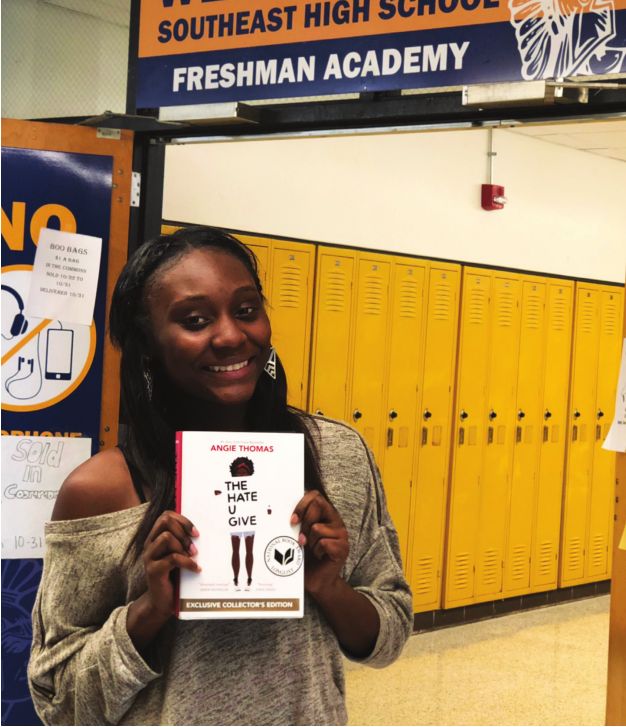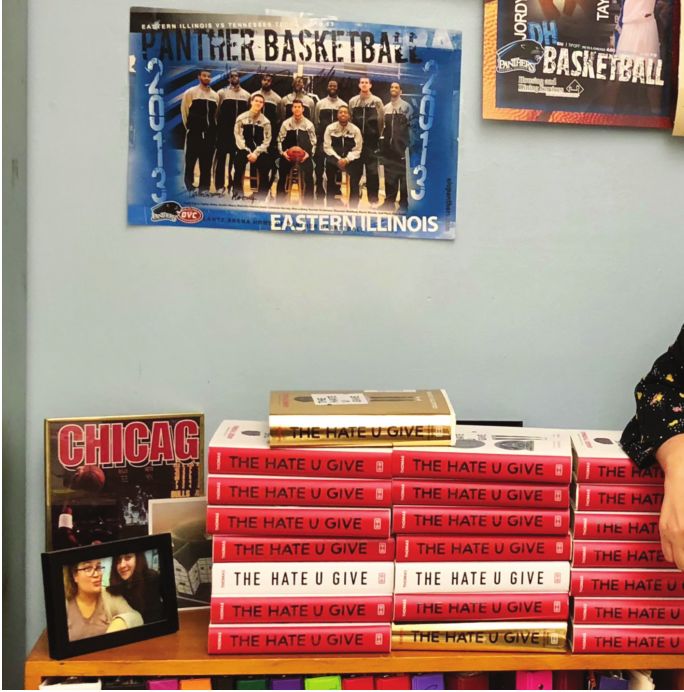
Early this month, a Springfield teacher took a group of students to a movie theater to view a popular new teen drama based on a bestselling novel. It was a special screening just for students who had earned the right to be there by reading the book and writing a paper about it. Of course, using a movie to bribe kids into reading literature is one of the oldest tricks in the teacher playbook. But that’s not what was happening with this movie, this piece of literature and this teacher.
The teacher is Kathryn “Kassie” Jones. She teaches literature, creative writing and journalism at Springfield Southeast High School. Named for its location in an economically challenged part of town, Southeast has the highest percentage of African-American students of any high school in the Springfield district.
“Sometimes I feel like Southeast has the – I don’t know if it’s pressure? Or like celebration? – of being ‘the black school,’” she says. “And I can’t speak for other high schools because I really don’t know very many people who go to those high schools or who teach at those high schools, but I know at Southeast, it’s OK to be black. And it’s OK to have black culture and be proud of black culture.”
Jones, who is white, graduated from Rochester High School – in a small, prosperous suburb six miles away. But look
around her classroom and it’s clear she’s made Southeast her home. Over
the eight years she’s taught here, she’s filled an entire wall of
bookshelves with young adult novels, and plastered every surface with
snapshots of students holding their favorite books. She prides herself
on being able to match every reluctant reader with a book they’ll love,
and then keeping that fire lit. One way she does that is through a book
club she started seven years ago.
“The
very first year I did it, I did it with kids that were like struggling
readers,” she says. “We were reading this series of books – the
Hazelwood High trilogy. We don’t teach the third book, but we have
copies of the third book. So I thought it was kind of just like the
perfect time to start a book club. I was like, ‘Well, come after school
and we’ll read the next one, and I’ll have snacks and stuff.’ And after
that, it just kind of spun into its own little thing.”
The
club churns through anywhere from seven to nine books per year. The
students choose which books to read through a complicated democratic
process that Jones tries to stay out of. The club went through a
dystopian phase with The Hunger Games and Divergent series, and more recently explored LGBTQ issues with Dreadnought, We are the Ants and Beautiful Music for Ugly Children.
“They
also love books that are being made into movies, because they know I’m
going to take them, or we’re going to watch it here,” she says. “Like
last week, we watched To All The Boys I’ve Loved, which is a Netflix movie, but we read the books and I had pizza and we watched the movie. It garnered some excitement.”
Jones wasn’t aware they had chosen another movie-bound book last year when they selected The Hate U Give. It was on the New York Times best seller list for young adult fiction, and its subject matter was painfully relevant. The Hate U Give is
told from the perspective of a 16-yearold black girl who sees her best
friend killed by a white police officer, then learns to speak out as the
sole witness to his death.
Author
Angie Thomas packed 450 pages with subplots like interracial dating,
how to handle that friend whose jokes just happen to be racist, what it
feels like to constantly codeswitch, and what it means when a family
leaves a traditionally black neighborhood to move to the suburbs.
She also adds sprinkles of humor every few pages, like when the lead
characters pause during an especially tense situation to argue about
whether mac-and-cheese is a side dish or a full meal.
Still, the name of the book – and the movie – forms the acronym THUG. The phrase was popularized by the rapper Tupac Shakur.
“You
know, he had THUG LIFE tattooed across his stomach,” Jones says. “And
he said that THUG LIFE is The Hate U Give Little Infants F***s Everyone.
Meaning that if you treat a group of people badly since the time they
were born, they’re going to mess up society, and there’s going to be
issues, and you’re going to pay for it later. That’s THUG LIFE.”
Jones found out The Hate U Give had been made into a movie when Southeast alums started emailing her.
“Old
students just sent me the link and ‘Have you seen the trailer?’ because
I’d been pushing the book for so long,” she says. “They were really
excited, and I knew I had to do something with this.”
What
she decided to do was to go beyond her book club and promise to take
every Southeast student who read the book to see the movie in a theater.
In order to make it as accessible as possible, she wanted to have the
book available for every student who might want to read it. The school
librarian had fewer than 10 copies. Jones herself had 20. She knew she
needed more.
“So I
just kind of threw it up on Facebook,” she says. From there, her post
was shared and re-shared. “And people started sending books to
Southeast. And I don’t know who sent them. They didn’t even have
addresses attached. I would say that we had at least 75 copies donated,
and every one of those copies was passed out to a kid.”
One
book went to QwaDimeyion Perry. As a senior, she didn’t need to read
this book for a class; she told me she was reading it just for fun,
inspired by seeing the movie trailer.
“Reading’s not a big part
of my life. I don’t like to read at all,” she told me. “I have to be
really interested in something or I just won’t read it.”
She finished it a few hours before boarding the bus to the theater.
Another
book went to ninth-grader Faith Bondon, who, like QwaDimeyion, says she
isn’t usually interested in reading. But she sped through The Hate U Give in
two weeks. Part of what kept her from tossing the book aside was the
author’s pitch-perfect use of teen slang – a talent rarely found in
full-fledged adults.
“I
think she really did good. Like, if my parents were to try to do it,
I’d be like ‘STOP!’ But like for her, I don’t know, it’s like she’s in
our century but just older. She knew exactly where to use it and how to
use it in the right way.”
Faith and QwaDimeyion are both black, but Jones says white students came asking for the book too.
“All different types of white kids,” she says.
“You’ve
got your white kids who hang around black kids, and they understand the
culture and they understand people. And then you’ve got your white kids
who are a little more seg regated and they kind of just hang out with
people that look like them. And THOSE kids were asking for the book.
That’s what I really found astounding and really awesome.”
And one copy went to a student who just needed something to read to keep him from annoying his science teacher.
“His
science teacher emailed me and said, ‘You’ve got to give Sean a book.
He keeps finishing early and he keeps just talking. You’ve got to give
him a book,’” Jones says. “So I put this on his desk. He said, ‘There’s
no way I’m reading a 400-page book!’” The next day, 14-year-old Sean
Skenandore told Jones he was on page 140, having stayed up till midnight
reading the first three chapters aloud, over the phone, to his
girlfriend.
“It usually takes me like two months to read a book,” Sean told me. He prefers to play video games. He read The Hate U Give in about a week.
This story originally appeared on NPRillinois. org, where Dusty Rhodes is the Education Desk reporter.